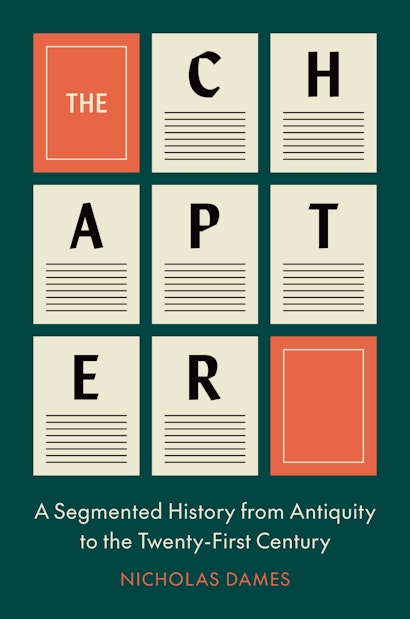Very few adult readers are likely to remember it, but imagine, if you will, your first experience reading a book divided into chapters. What confronted you was a story that unexpectedly stuttered. These strange pauses also seemed to have their own rules or habits. They were likely numbered (“Chapter Two”); these units made you count, even possibly, in some way, added up. They probably had titles too, indicating that what followed was something unto itself, a segment with its own contours of meaning, while belonging to a bigger set and broader process. You were being, in a new way, navigated through a story, nudged at intervals.
Now you were, of course, likely already old enough to experience everyday time in this way. Days themselves probably felt less like the fresh starts they once had seemed; you were increasingly aware of being tethered to ongoing experiences—worries, longings, plans, obligations—that persisted across the little interruptions of sleep or absence. But the chapter break might have still felt peculiar, even exciting. It gave you freedom by inviting you to pause, perhaps even stop. It also challenged you to return later and resume the story. Perhaps it synchronized the story to the routines of daily life: “one more chapter before bedtime,” you might’ve been told. From the beginning, then, this new kind of reading was schooling you in a rhythm. It was tacitly instructing you to look for the transitions, the gaps or moments of temporary abeyance, in any longer temporal process—those shifts that are neither true beginnings or endings but that can look a little like both.
I’ve described this half-imagined, half-remembered experience in order to suggest that there are profound adjustments involved in learning to read those innocuous, inescapable textual units called “chapters.” Their profundity also signals something else, which is that the chapter has a long, complex history; it is the result of a gradual evolution of an ancient technique. Across the English-speaking world those children’s books in which we first experience chapters are now called “chapter books,” a relatively recent marketing term for a stage of literacy, achieved at roughly ages 7 to 10, in which one is ready to consume continuous narratives that are too long to be read in a single sitting. But books in chapters are far older than this term, older even than the form of book, the codex, that has been standard for almost two millennia. The adjustments involved in learning to read “chapter books” are the residue of the many, changing tasks the chapter as a tool has been asked to perform, all of which are embedded in even the humblest chaptered story for young readers.
The first chapter books were not, in fact, narratives at all. They were ancient informational texts: assemblages, like Pliny the Elder’s Natural History or Aulus Gellius’s Attic Nights, that compiled a wide range of knowledge in a given field, such as medicine, law, language, or military science. These were vast, often messy texts, not intended to be read consecutively, and organized in short topical units. The “chapter,” or caput, was a way to label these units (caput or “head” signifies the “main things” encapsulated in a label) and tie them to a list of headings or a proto-index in order to facilitate what is often called discontinuous access, meaning the ability to locate the precise topic or passage one wanted to consult. These early “chapters” were present in scrolls, the most common book-form of classical antiquity, and even on large public inscriptions such as legal tablets. They were navigation aids, labor-saving intellectual tools. They imagined texts as modular collections of discrete units, each unit with its own separate rationale, yet with its place in a network of other such units.
From the standpoint of our world of algorithmic search functions, this early finding device seems familiar. We understand its necessity; it gives us a window into how antiquity was already experiencing its own kind of information overload. But something peculiar happened to the chapter early on in its history. Scribes, or what we might now call editors, increasingly looked to divide and label continuous narrative texts—to “chapter” stories, not just collections of knowledge. This was its own, newer kind of intellectual labor, in which by segmenting a text and labeling those segments, to “outline” its parts, one comes to better understand it. By the era now known as late antiquity, this work of “capitulation” was a primary output of scholars. Scriptoria and research centers like that of the 6th-century Ostrogothic scholar Cassiodorus produced many different capitulations of Biblical narratives, each of them functioning as guides—even, perhaps, useful shortcuts—to understanding.
When a narrative text is chaptered, however, the function of the chapter inevitably begins to mutate. It becomes a technique for registering time—for patterning it, establishing a sequence of beats and pauses. The chapter emerges as a rhythmic notation, even a kind of textual clock, synchronizing us to the story’s internal timing. Call it a temporal GPS: the chapter increasingly exists to tell us where we are in an unrolling linear experience. These rhythmic signatures introduced by the chaptering of narrative texts can also be reimagined at different historical moments. The Christian Gospels, for instance, were chaptered in multiple ways from the 4th century to the 13th. Some versions offered many brief chapters, others fewer, longer ones. Each chaptering system imagined a slightly different relation to the question of what kinds of units of time are meaningful ones: does meaning inhere in an utterance, an action, a collection of actions in a single day, a longer sequence of actions? What is the unit of time in which our lives take on significance, how long is its duration? A chapter is a way of answering those questions.
From late antiquity through the medieval period, these questions were the domain primarily of editors who divided up the texts they reproduced. William Caxton, the first British printer, himself chaptered most of the texts that passed through his workshop, from histories to prose romances, bringing the ancient labor of capitulation into the age of mechanical reproduction and giving a particular rhythm to the texts he printed. In this, Caxton worked much as Cassiodorus had. But the truly important shift was happening more gradually, and picked up pace in the centuries after print’s spread. Increasingly, chapters shifted from editorial to authorial labor. They became not just a component of a text’s publication, but a compositional form, something authors could experiment with and meditate upon.
Nowhere was that experimentation clearer than in that literary form intimately associated with the printing press: the novel. Chapters in novels no longer primarily indexed topics; they organized time into phases, stages, significant moments. They offered occasions for momentary reflection, not to mention chatty communication between narrator and reader. They reflected a different labor, that of temporal imagination. The heading or label, that which gave the “chapter” its name, lingers on but in a different mode. “In Which the Story Pauses a Little”: this chapter title, from George Eliot’s 1859 Adam Bede, exemplifies how the novelistic chapter is a technique of gaps and pauses and caesuras, of rhythmic beats, instead of a locating device or label. And so we absorb that technique into our ways of thinking about our lives, our pasts, the structure of our selves. To “close that chapter of my life” with regret; to excitedly “start a new chapter” of a career, a friendship, a romantic life; the sense that this “new chapter” will feel both different and yet also familiar: these are at once experiences of reading and of living. They are the ways our lives, in fact, take on the shape of a book. It is this patterning, with its more than two-thousand-year-old history, that we begin to learn when we first open a “chapter book.”
Nicholas Dames is the Theodore Kahan Professor of Humanities at Columbia University and an editor in chief of Public Books. He is the author of The Physiology of the Novel: Reading, Neural Science, and the Form of Victorian Fiction and Amnesiac Selves: Nostalgia, Forgetting, and British Fiction, 1810–1870.

